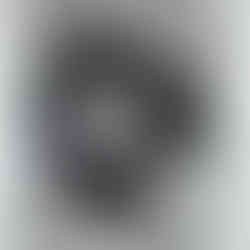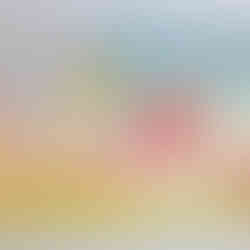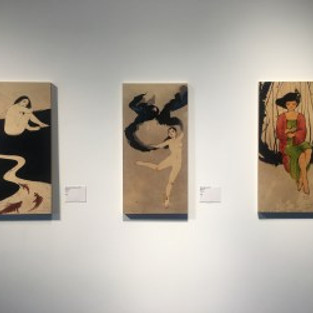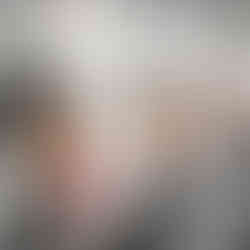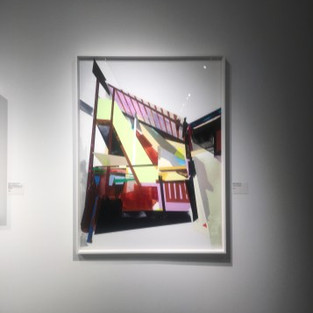
MFA Biennial, Brea Gallery; Photo credit Evan Senn
MFA Biennial Proves the Future is Bright
through March 25 Brea Art Gallery, Brea
By Evan Senn Southern California is an epicenter for creative expression and education. For over a decade, galleries across the world look to the Southern California area for the next generation of artistic talent for the market. The City of Brea is not a destination for art lovers, but the location of the city gives this area a perfectly unique position, in between many of the locations of the best graduate schools for art in the Southern California area. The City of Brea Art Gallery hosts an MFA Biennial, in its fourth iteration currently, showcasing the amazing talent and innovation in the graduate art students in the surrounding institutions. Featuring fascinating works from students representing Claremont Graduate University (CGU), CSUN, CSULB, CSUF and Otis College of Art and Design (OCAD), this year’s MFA Biennial provides hope and generous amounts of inspiration for our future and our creative spirit in this area.
Walking through the exhibition, right off the bat, magic and color twinkle and dance with the human experience in the work of CGU student Aurora Berger’s photographs. Simple glitter and black fabric are used to evoke a sensory experience of a faraway galaxy, or the twinkle of city lights against the night sky. Berger’s art practice is inspired by a visual disability that has guided her fascination in art-making toward a sense of perceptual play and deconstructing the ways in which we understand our visual world.
Across from Berger’s photographs, Michael Roman’s illustrations of urban life and spirit are hypnotic and romanticized expressions of simple moments in the complicated lives of overlooked individuals in urban communities. Gorgeous compositions made in charcoal over pen and ink, Roman’s monochromatic creations are evocative and emotionally charged, but are imbued with a strength and spirituality that usual images of urban lives are not equipped with. The representations in his work leave viewers feeling a compelling sense of purpose from his subjects, and a notion that there is more than what we can see.
At the end of the first corridor, through a dark curtain emerges a colorful and meditative experience through the work of Michelle Nunes from CSUN. Her experiential installation is beautiful and magnetic, pulling viewers in to become a part of the multifaceted experience. Purple and golden light push and pull at one another, while floating pot-less potted flowers hang in disarray, slightly twirling in the idle of the space. An abstract video plays on one wall and interacts with the other material and ephemeral components in this work in thoughtful and imaginative ways. The whole experience touches on the ways our human brain associates with material, spiritual and emotional experience in this world–the experience and the space never stop moving, keeping our imagination moving in stride with the sound, colors, shapes and energy of the installation.
Chloe Jeongmyo Kim is a Korean artist and student who had been tugged and pulled to many different cities and countries throughout her youth by her family. With the visual influence from a variety of cultures and places, and a strong association with displacement as well as a longing for a sense of home, Kim’s adult personality turned out just like her art–a beautiful assortment of materials, influences, textures and opacities. The ease of assimilation had become a strength for Kim, after a lifetime of uprooting, exploring, and adjusting to new places and people. Her art suggests something similar–she uses plexiglass and resin to encase her collections of thoughts, feelings and experiences. With a variety of shapes and colors along with an assortment of textures and mixed media, Kim’s fragmentary compositions explore fantastical abstract experiences that resemble places and visual perspectives from a human eye. They are composed and compelling insights that offer clues to the human heart and mind.
Turning a corner from Kim’s assimilations, the work of CSUF graduate student Caesar Alzate Jr. stops you in mid-step. The brightly colored sculptural paintings look as if they were magnetized and pull the viewers in with as much force as a magnet pulls a piece of metal toward it. Seemingly simple presentations of color and the physicality of paint are so much more complex as you get closer to them. Black, white, blue and red pieces by Alzate beg you to touch and feel the structures that protrude from the surface of the works. Alzate’s inspiration for is part personal and part political. His “paintings” mimic organic growth accompanied by a deeper conceptual metaphor that signifies the idea of “The Other” in identity politics. The red and blue pieces have a center to the movement of the sculptural paint that is unlike the black and white pieces–these centers resemble a cyclone or tornado, further supporting the visual metaphors of community, othering, and the feeling of being an outsider. Alzate is a colorblind artist, and fights discrimination on a variety of fronts in his own life. His work, although completely abstract, blurs boundaries physically and conceptually, making viewers reconsider what a painting is, what a sculpture is, what community is, and what art is.
In a similar way, Jesse Parrott from CSULB evokes questions and concerns about the definition of art and authority in his work. Using whimsy and components of modern life into his works, he forces the viewer to confront the significance of objects and images while offering relation through context and association. How many Netflix DVDs make a house a home? How do you follow the strict rules of society and still experience the world in ways that are meaningful and personalized? His objects and installations are rebellious acts of pristine reflection and association that evoke sneaky smirks and private thoughts. Although his multifaceted works are stagnant and still, the visual components and materials represented in his works offer moments of personal reflection and rebellion against authority that brings with it a sense of empowerment and ownership.
Amy E. Williams’ floating ceramic and fiber installations are in the far corner of the gallery space and are tactile explorations in life and growth. Visually similar to alien egg sacks or hanging gardens, Williams explores the details of life and the natural world through porcelain slip, paper, and string. Reminiscent of the postmodern material nature of Eva Hesse’s work, Williams’ work holds feminine energy wit its shapes and presence in the space, but embody a timelessness that tugs on the nature of life itself.
The last stop in the maze of corridors in the gallery space is bright and emotive. The walls are covered in huge, abstract paintings by Megan Kinney and focus on the concept of how we as human beings take up space and how that space affects us. The abstract pieces resemble messy studies of flesh, piles and masses of color, scars, rolls and bends. Inspired by a lifetime of concern over her body weight and image, Kinney’s work makes us consider what kind of space our flesh takes up, and what kind of weight keeps us heavy and grounded. The emotional qualities in the compositions range in gesture and vibrancy, but the effect of making the viewer become more self-aware in the process of viewing these works is fascinating and powerful. All of the work in this exhibition relay a powerful sense of self and self-awareness, reminding viewers to feel and think about themselves and how they are an active part of the world around them.
Brea Art Gallery 1 Civic Center Circle, Brea breagallery.com
#losangeles #california #losangelesartist #MichelleNunes #art #painting #familylife #csun #nudes #OCAD #AmyEWilliams #MFABiennial #losangelesart #contemporaryart #arttheft #BreaArtGallery #artistrunspace #otiscollegeofartanddesign #abstract #collage #JesseParrott #feminist #photography #artgallery #evansenn #csuf #gallery #genderroles #CSULB #artandcake #artopening #assemblage #artexhibition #climate #ArtandCakeLA #fineart #artists #artist #AuroraBerger #mixedmedia #arts #environment #artreview #sculpture #nature #artmagazine #artcollective #ArtandCulture #exhibition #Brea #latinamericanart #CaesarAlzateJr #Mexicanartist #MeganKinney #exhibit #dtla #MichaelRoman #ClaremontGraduateUniversity #ChloeJeongmyoKim #drawing #climatechange





